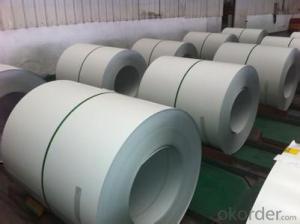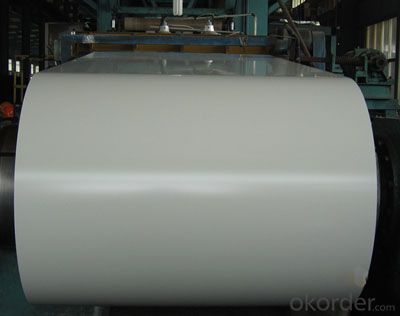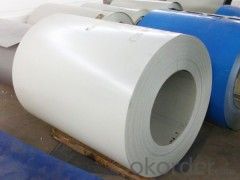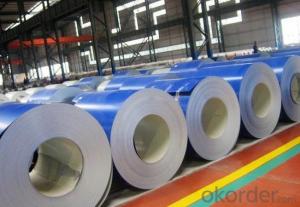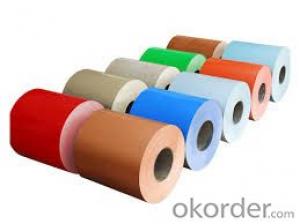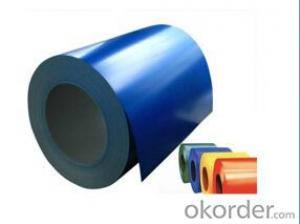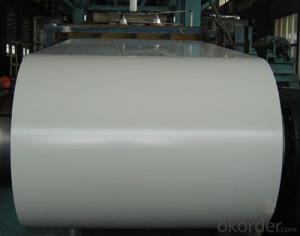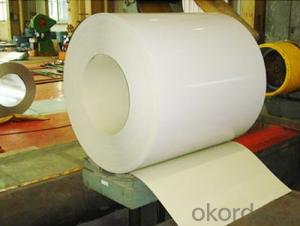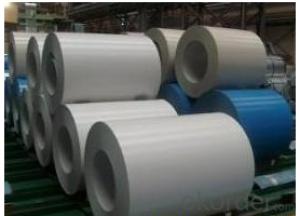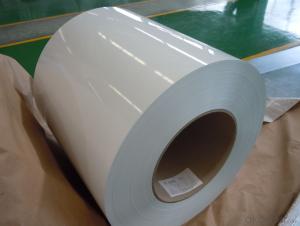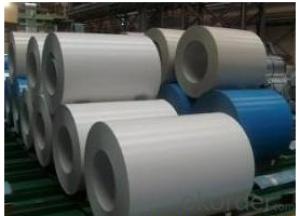Pre-painted Galvanized/Aluzinc Steel Sheet Coil with Prime Quality , White Color
- Loading Port:
- Shanghai
- Payment Terms:
- TT OR LC
- Min Order Qty:
- 50 m.t.
- Supply Capability:
- 20000 m.t./month
OKorder Service Pledge
OKorder Financial Service
You Might Also Like
1.Structure of Pre-painted Galvanized/Aluzinc Steel Coil Description
With GI (aluzinc) as base metal, after pretreatment (degrease and chemical treatment) and liquid dope with several layers of color, then after firing and cooling, finally the plate steel is called pre-painted galvanized (aluzinc) steel. Pre-painted galvanized steel is good capable of decoration, molding, corrosion resistance. It generally displays workability, durability and weather resistance.
2.Main Features of the Pre-painted Galvanized/Aluzinc Steel Coil
• Excellent corrosion resistance
• Excellent weather resistance
• Capability of decoration, molding, corrosion resistance
• Workability, durability
• Excellent heat resistance performance
• High strength
• Good formability
• Good visual effect
3.Pre-painted Galvanized/Aluzinc Steel Coil Images


4.Pre-painted Galvanized/Aluzinc Steel Coil Specification
Quality standar: JIS G3312 CGCC & CGLCC
Hardness of P: Both soft and hard quality are available
Surface finish: with or without protect film
Thickness : 0.14-1.20 mm
Width : 914mm, 1000mm, 1220mm and 1250mm, thickness 600-1250mm is available
Finish by coil or sheet: Both sheet and coil are available
8Zinc coating: 60-275G/M2, both sides
Paint thickness for top side : 5 micron primer + (10-20) microns modified polyester, any RAL color code.
Paint thickness for back side: (5-10) microns Epoxy
Weight per coil: 4-6 tons, also can be upon customer's requirements
Max loading weight in one 20ft container : 25 tons generally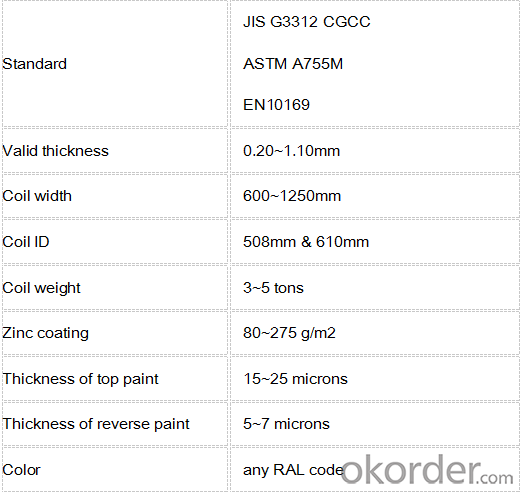
5. FAQ of Pre-painted Galvanized/Aluzinc Steel Coil
We have organized several common questions for our clients,may help you sincerely:
1. What is the minimum order quantity ?
Our MOQ is 50mt for each size. And we will consider to give more discount if you make big order like 1000 tons and more. Further more, the more appropriate payment term your offer the better price we can provide.
2. How long can we receive the product after purchase?
Usually within thirty working days after receiving buyer’s advance payment or LC. We will arrange the factory manufacturing as soon as possible. The cargo readiness usually takes 15-25 days, but the shipment will depend on the vessel situation.
3. How to guarantee the quality of the products?
We have established the international advanced quality management system,every link from raw material to final product we have strict quality test;We resolutely put an end to unqualified products flowing into the market. At the same time, we will provide necessary follow-up service assurance.
- Q: What are the dimensions of steel coils used in the appliance industry?
- The dimensions of steel coils used in the appliance industry can vary depending on the specific application and manufacturer. However, common dimensions for steel coils in the appliance industry range from 0.15mm to 6mm in thickness and 600mm to 2000mm in width.
- Q: i cant find this stuff about steel:conductivitystrengthcorrosion resistancecommon applicationsif you know of any interesting facts, i could use those 2!thanx!
- go okorder and search for steel.......
- Q: What are the common challenges in steel coil manufacturing?
- Some common challenges in steel coil manufacturing include maintaining consistent quality, managing the weight and size of coils, ensuring proper surface finish, minimizing defects such as dents or scratches, preventing coil damage during handling or transportation, and optimizing production efficiency to meet customer demands.
- Q: What are the different types of surface treatments for steel coils?
- There are several types of surface treatments for steel coils, including galvanizing, painting, and coating. Galvanizing involves applying a layer of zinc to protect the steel from corrosion. Painting involves applying a layer of paint to provide both corrosion resistance and aesthetic appeal. Coating involves applying a thin layer of protective material, such as polymer or epoxy, to enhance the steel's durability and resistance to corrosion. These surface treatments are chosen based on the specific requirements of the steel coils and the desired end-use applications.
- Q: How are steel coils labeled for identification?
- Steel coils are typically labeled for identification using stickers or tags that contain information such as the coil number, dimensions, weight, grade, and other relevant details.
- Q: Is sterling silver better than surgical steel as far as being hypoallergic in earrings? If I have a choice which should I get? Thanks!
- Surgical steel.
- Q: How are steel coils used in the production of automotive stampings?
- Automotive stampings heavily rely on steel coils, which are vital for their production. These coils are typically crafted from top-notch steel and are cut into specific measurements to meet automotive manufacturers' specifications. To begin the process of using steel coils for automotive stampings, the steel must first be uncoiled. This task is accomplished by a machine called a decoiler, which unwinds the coil and feeds it into the stamping machine. By utilizing the decoiler, a consistent supply of steel is ensured for the stamping process. Once the steel coil is unwound, it is inserted into the stamping machine. Equipped with a die specifically designed for shaping the steel into desired automotive components, the machine commences its work. The die is capable of creating intricate and accurate shapes, such as car body panels, doors, fenders, and structural elements. By applying force, the stamping machine presses the steel coil against the die, forming it into the desired shape. The high-quality steel utilized in the coils guarantees that the stamped components possess the necessary strength and durability required for automotive applications. Following the stamping process, the stamped components undergo a thorough inspection to assess their quality and precision. Any flaws or defects are identified and rectified prior to the components being sent for further processing, including painting, welding, or assembly. In conclusion, steel coils are of utmost importance in the production of automotive stampings. They provide a continuous supply of high-quality steel, which is skillfully shaped into precise and long-lasting automotive components. The utilization of steel coils ensures that the automotive stampings adhere to the required standards for strength, durability, and precision.
- Q: I like steel strings but don't want to get a new guitar. Is that my only option?
- It will permanently ruin the guitars neck. Acoustic guitars have an adjustable metal rod in them called a “Truss Rod” that allows the neck to withstand steel string tension. How about putting on high tension nylon strings ?
- Q: How are steel coils protected from mechanical damage?
- Steel coils are typically protected from mechanical damage through the use of various packaging materials such as wooden crates, steel frames, or protective plastic wraps. These measures ensure that the coils remain intact and safeguarded during transportation, handling, and storage, minimizing the risk of any potential mechanical damage.
- Q: How are steel coils used in the manufacturing of bridges?
- Steel coils are used in the manufacturing of bridges as they provide the raw material for creating structural components such as beams, girders, and columns. These coils are processed and shaped into the required sections, which are then assembled and welded together to form the bridge's framework. The strength and durability of steel make it an ideal material for constructing bridges that can withstand heavy loads and harsh environmental conditions.
Send your message to us
Pre-painted Galvanized/Aluzinc Steel Sheet Coil with Prime Quality , White Color
- Loading Port:
- Shanghai
- Payment Terms:
- TT OR LC
- Min Order Qty:
- 50 m.t.
- Supply Capability:
- 20000 m.t./month
OKorder Service Pledge
OKorder Financial Service
Similar products
Hot products
Hot Searches
Related keywords
